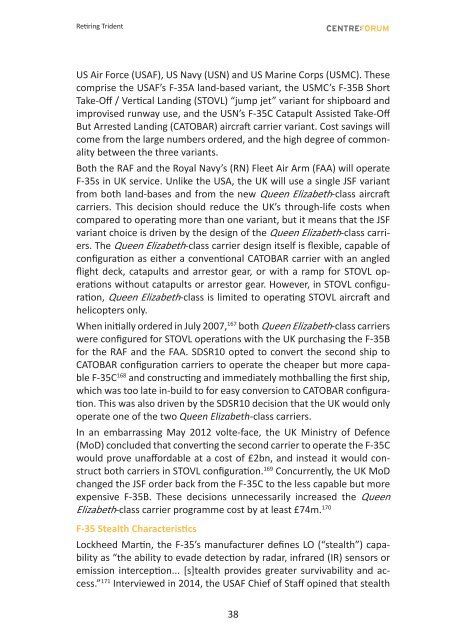Retiring Trident
retiring-trident
retiring-trident
You also want an ePaper? Increase the reach of your titles
YUMPU automatically turns print PDFs into web optimized ePapers that Google loves.
<strong>Retiring</strong> <strong>Trident</strong><br />
US Air Force (USAF), US Navy (USN) and US Marine Corps (USMC). These<br />
comprise the USAF’s F-35A land-based variant, the USMC’s F-35B Short<br />
Take-Off / Vertical Landing (STOVL) “jump jet” variant for shipboard and<br />
improvised runway use, and the USN’s F-35C Catapult Assisted Take-Off<br />
But Arrested Landing (CATOBAR) aircraft carrier variant. Cost savings will<br />
come from the large numbers ordered, and the high degree of commonality<br />
between the three variants.<br />
Both the RAF and the Royal Navy’s (RN) Fleet Air Arm (FAA) will operate<br />
F-35s in UK service. Unlike the USA, the UK will use a single JSF variant<br />
from both land-bases and from the new Queen Elizabeth-class aircraft<br />
carriers. This decision should reduce the UK’s through-life costs when<br />
compared to operating more than one variant, but it means that the JSF<br />
variant choice is driven by the design of the Queen Elizabeth-class carriers.<br />
The Queen Elizabeth-class carrier design itself is flexible, capable of<br />
configuration as either a conventional CATOBAR carrier with an angled<br />
flight deck, catapults and arrestor gear, or with a ramp for STOVL operations<br />
without catapults or arrestor gear. However, in STOVL configuration,<br />
Queen Elizabeth-class is limited to operating STOVL aircraft and<br />
helicopters only.<br />
When initially ordered in July 2007, 167 both Queen Elizabeth-class carriers<br />
were configured for STOVL operations with the UK purchasing the F-35B<br />
for the RAF and the FAA. SDSR10 opted to convert the second ship to<br />
CATOBAR configuration carriers to operate the cheaper but more capable<br />
F-35C 168 and constructing and immediately mothballing the first ship,<br />
which was too late in-build to for easy conversion to CATOBAR configuration.<br />
This was also driven by the SDSR10 decision that the UK would only<br />
operate one of the two Queen Elizabeth-class carriers.<br />
In an embarrassing May 2012 volte-face, the UK Ministry of Defence<br />
(MoD) concluded that converting the second carrier to operate the F-35C<br />
would prove unaffordable at a cost of £2bn, and instead it would construct<br />
both carriers in STOVL configuration. 169 Concurrently, the UK MoD<br />
changed the JSF order back from the F-35C to the less capable but more<br />
expensive F-35B. These decisions unnecessarily increased the Queen<br />
Elizabeth-class carrier programme cost by at least £74m. 170<br />
F-35 Stealth Characteristics<br />
Lockheed Martin, the F-35’s manufacturer defines LO (“stealth”) capability<br />
as “the ability to evade detection by radar, infrared (IR) sensors or<br />
emission interception... [s]tealth provides greater survivability and access.”<br />
171 Interviewed in 2014, the USAF Chief of Staff opined that stealth<br />
38




